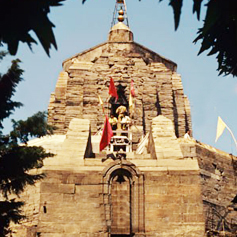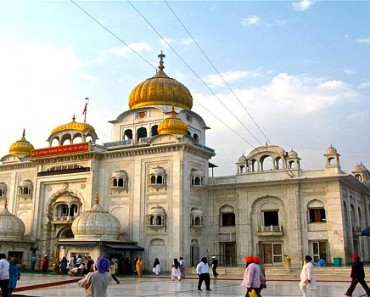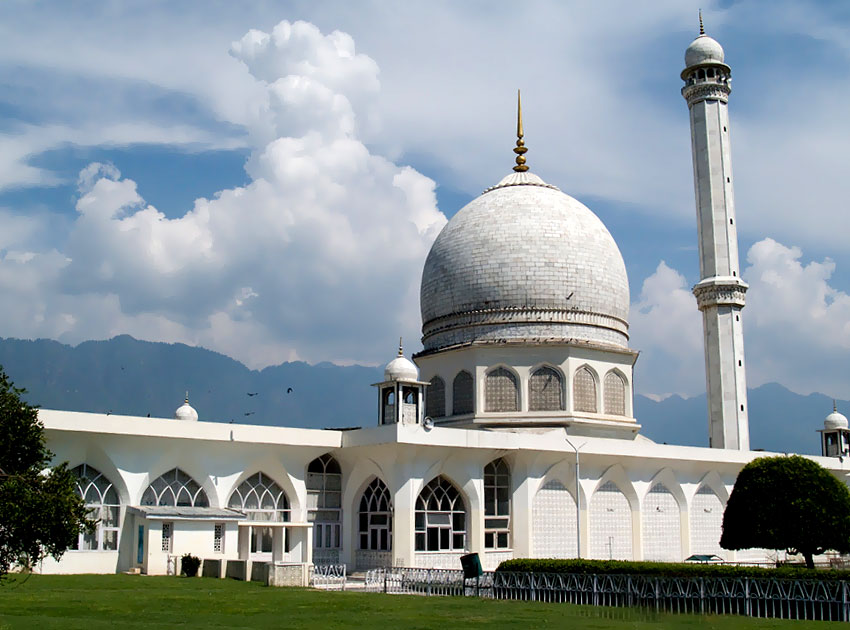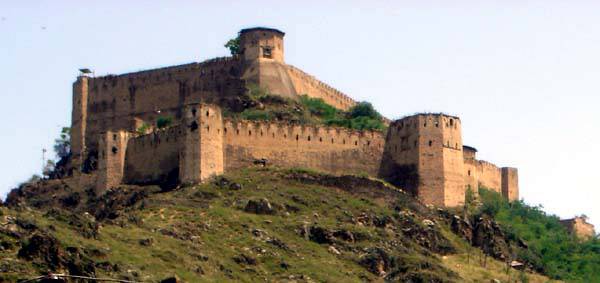Shankar Achariya
A beautiful Shiva temple situated on a picturesque location on the Gopadari Hill on the South East of Srinagar. This temple is situated at a height of 1100 feet above the Srinagar city The name of the Temple is after the great philosopher Shankaracharya who visited the valley about ten centuries ago.

The Temple is built on a high octagonal plinth approached by a flight of steps.Shankarachar is a detached ridge of igneous rock to the south-east of Srinagar, separated from the Shilamar Range by the Aita Gaj Gap. The summit of the hill is crowned with a picturesque edifice.
This hill was called Jetha Larak and afterwards it was named Gopadari Hill. Some are of opinion that the temple at the top was originally built by King Sandiman (2629-2564 B.c.). There were 300 golden and silver images in it. About 1368 B.C. King Gopadittya founder of Gopkar repaired it and bestowed to the Brahmans of Arya Varta, agrahars which he built on its top. King Sandimati (34 B.C.-A.D. 13) improved and added to the temple.
Zain-Ul-Abdin (1421-1472 A.D.) repaired its roof which had tumbled down by an earthquake. Sheikh Ghulam Mohi-Din, a Governor (1841-46) also repaired its dome. Recently, the dome was repaired by Swami Shivratnanand saraswati at the request of a Nepali Sadhu who gave him financial aid.
GurdwaraGurdwara Chatti Patshahi, Kathi Darwaja, Rainwari, Srinagar is one of the most important Sikh Gurudwaras in Kashmir. This historical Gurdwara is included in the tourist place of Srinagar city of Kashmir valley. It is situated
 just outside the southern gate of Hari Parbat fort.
just outside the southern gate of Hari Parbat fort.
The sixth guru of Sikhism travelled through Kashmir, stopping to preach occasionally and stayed for fewdays. Gurdwara Chhevin Patshahi - Srinagar, on the bank of Jhelum Riverand Dal Lake, is located at the site which was visited by Guru Nanak Dev and Guru Hargobind as well.
Some sources also list a visit by GuruHar Rai, but the historical Sikh shrine here is named after Guru Hargobind alone the Chhevin Patshahi or Sixth Master, it is located outside Kathi Gate of Hari Parbat Fort at the site of the house of MaiBhagbhari, who had long been yearning for a glimpse of the Guru when Guru Hargobind fulfilled her wish by his visit and wearing of her now famous gown.
The Gurdwara comprises a rectangular hall with the sanctumin the middle and a spacious terrace in front. An old well nearby issaid to have been dug on the orders of Guru Hargobind.
Hazratbal
The Hazratbal Shrine, is situated on the left bank of the famous Dal Lake in Srinagar. This unmatched reverence is anchored in the love and respect for the Prophet Muhammad (peace be upon him), whose Moi-e-Muqqadas, the sacred hair from the beard of Prophet Muhammad (peace be upon him) is preserved here.

The Hazratbal mosque is situated in Srinagar only 8 Kms from Lal Chowk and 7 Kms from Tourist Reception Center, on the western banks of the picturesque Dal Lake. Facing the beautiful Nishat Bagh, the mosque offers a spectacular view of the lake and the mountain afar.
This revered shrine houses the Moi-e-Muqqadus (preserved sacred hair) of Prophet Muhammad (peace be upon him). Public display of the Moi-e-Muqqadas takes place only on religious occasions.
Some of the other names of the Hazratbal mosque are Assar-e-Sharief, Madinat-us-Sani and Dargah Sharif. One of the most revered Muslim shrines, Hazratbal is an epitome of the love and respect of Muslims for the Prophet.
The Hazratbal Mosque of Kashmir is a beautiful structure of immaculate white marble. The Muslim Auqaf Trust headed by Sheikh Mohammad Abdullah started the construction work on this marble structure in 1968.
.
Hari Parbat
Hari Parbat is a hill overlooking Srinagar, the largest city and summer capital of Jammu and Kashmir, India. It is the site of a Durrani fort, built in 1808. It has the famous Shakti Temple on the western Slope and Muslim shrines of Khwaja

Makhdoom Sahib and Akhund Mullah Shah on the southern slope. On the southern side of the outer wall there is a Gurudwara, which commemorates the visit of Guru Hargobind.
The first fortifications on the site were constructed by the Mughal emperor Akbar in 1590. He built an outer wall for the fort, and planned a new capital called Nager Nagor to be built within the wall. That project was never completed. The present fort was built in 1808 under the reign of Shuja Shah Durrani.
The hill is considered sacred by the Kashmiri Pandits due to the presence of temple of Sharika. Temple is of goddess Jagadamba Sharika Bhagwati. She has 18 arms and is regarded as the presiding deity (`isht`-Devi) of Srinagar city.
The goddess is represented by a Swyambhu Shrichakra (Mahamaha Shrichakra), also called Mahashriyantra, which consists of circular mystic impressions and triangular patterns with a dot at the center. Sharika Devi is believed to be a form of Durga Mata or Shakti.